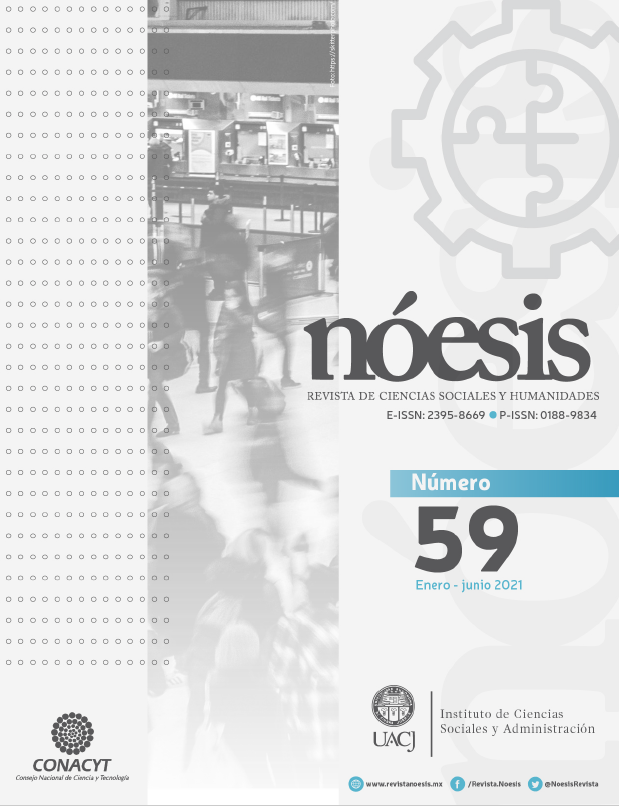Causalidad mediada: un modelo contemporáneo de coerción social
Contenido principal del artículo
Resumen
El propósito de este artículo es avanzar un modelo plausible de causalidad social, que llamamos de causalidad mediada.La primera parte del artículo se dedica a introducir algunas distinciones conceptuales básicas que definen los parámetros del modelo: qué tipos de entidades sociales ejercen qué tipo de coerción y sobre quiénes. La segunda parte avanza la estructura general del modelo que proponemos, explicando en qué sentido puede considerarse un modelo de causalidad y en qué sentido esa causalidad es social. Como resultado, el modelo define dos condiciones que deben satisfacerse para que se produzca un episodio de causalidad social mediada: (1) un individuo I consigue que otro, independientemente de su voluntad, produzca un comportamiento determinado (2) I lo consigue en virtud de la presencia de entidades tales como prácticas, posiciones y relaciones sociales.
Descargas
Detalles del artículo

Esta obra está bajo una licencia internacional Creative Commons Atribución-NoComercial-CompartirIgual 4.0.
Citas
Althusser, L. y Balibar, E. (1970). Reading capital (part 1). NLB.
Archer, M., Bhaskar, R., Collier, A., Lawson, T. y Norrie, A. (1998). Critical realism: essential readings. Routledge.
Bhaskar, R. (1998). The possibility of naturalism: a philosophical critique of the contemporary human sciences. Routledge.
Bhaskar, R. (2008). A realist theory of science. Routledge.
Boghossian, P. (2015) Rules, norms and principles: a conceptual framework. En Araszkiewicz, M., Banás, P., Gizbert-Studnicki, T. y Pleszka, K. (Eds.). Problems of normativity, rules and rule-following (pp. 3-12). Springer.
Boltanski, L. (2011). On critique: a sociology of emancipation. Polity Press.
Bourdieu, P. (1984). Espace social et gènese des “clases”. Actes de la Recherche en Sciences Sociales, 52-53, 3-14.
Bourdieu, P. (2007). El sentido práctico. Siglo XXI.
Brandom, R. (1994). Making it explicit: reasoning, representing and discursive commitment. Harvard University Press.
Brandom, R. (2002). Tales of the mighty dead: historical essays in the metaphysics of intentionality. Harvard University Press.
Bratman, M. (1993). Shared intention. Ethics, 104(1), 97-113.
Chant, S.R., Hindriks, F. y Preyer, G. (Eds.). (2014). From individual to collective intentionality: new essays. Oxford University Press.
De Caro, M. y McArthur, D. (2010). Introduction: science, naturalism and the problem of normativity. En De Caro, M. y McArthur, D. (Eds.) Naturalism and normativity (pp.1-19). Columbia University Press.
De Landa, M. (2006). A new philosophy of society: assemblage theory and social complexity. Continuum.
Durkheim, E. (1919). Les règles de la méthode sociologique. Libraire Félix Arcan.
Elster, J. (1982). Marxism, functionalism and game theory: the case for methodological individualism. Theory and Society, 11(4), 453-482.
Giddens, A. (1984). The constitution of society: an outline of the theory of structuration. Polity Press.
Gilbert, M. (1989). On social facts. Routledge.
Gilbert, M. (2014). Joint Commitment: how we make the social world. Oxford University Press.
Harré, R. y Madden, E. (1975). Causal powers: a theory of natural Necessity. Basil Blackwell.
Harré, R y Varela, C. (1996). Conflicting varieties of realism: causal powers and the problems of social structure. Journal for the Theory of Social Behaviour, 26 (3), 313-325. https://doi.org/10.1111/j.1468-5914.1996.tb00293.x.
Lawson, T. (2014). A conception of social ontology. https://www.csog.econ.cam.ac.uk/documents/AConceptionofSocialOntology.pdf
Lewis, P. (2001). Realism, causality and the problem of social structure. Journal for the Theory of Social Behaviour, 30(3), 249-268. https://doi.org/10.1111/1468-5914.00129.
List, C. y Petit, P. (2011). Group agency: the possibility, design, and status of corporate agents. Oxford University Press.
Marx, K. (1989). Contribución a la crítica de la economía política. Progreso.
Noguera, J. (2003). ¿Quién le teme al individualismo metodológico? Un análisis de sus implicaciones para la teoría social. Papers: revista de sociología, 69, 101-132. http://dx.doi.org/10.5565/rev/papers/v69n0.1285.
Oszlak, O. (2012), La formación del estado argentino. Ariel.
Schatzki, T. (1989). Social causality. Inquiry, 31(2), 151-170. https://doi.org/10.1080/00201748808602145.
Schatzki, T. (2002). The site of the social: a philosophical account of the constitution of social life and change. The Pennsylvania University Press.
Schmitz, M. (2017). What is a We-Mode account of collective intentionality?. En Preyer, G. y Peter, G. (Eds.). Social ontology and collective intentionality: critical essays on the philosophy of Raimo Tuomela with his responses (pp. 37-70). Springer.
Searle, J. (1995). The construction of social reality. The Free Press.
Searle, J. (2010). Making the social world: the structure of human civilization. Oxford University Press.
Tuomela, R. (2013). Social ontology: collective intentionality and group agents. Oxford University Press.

